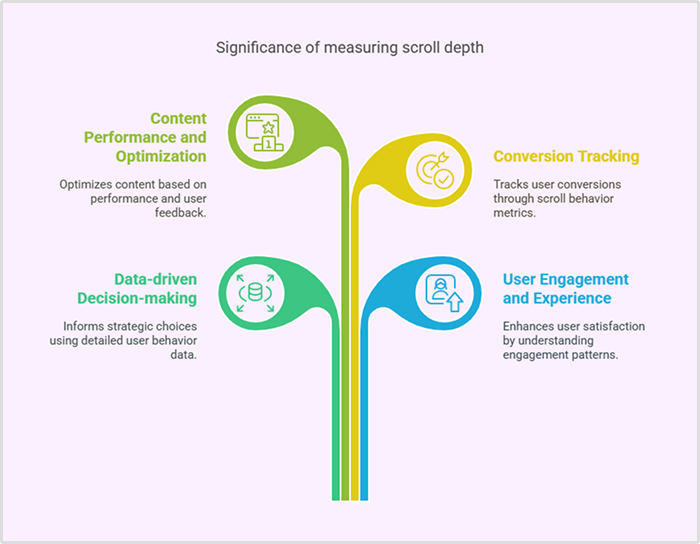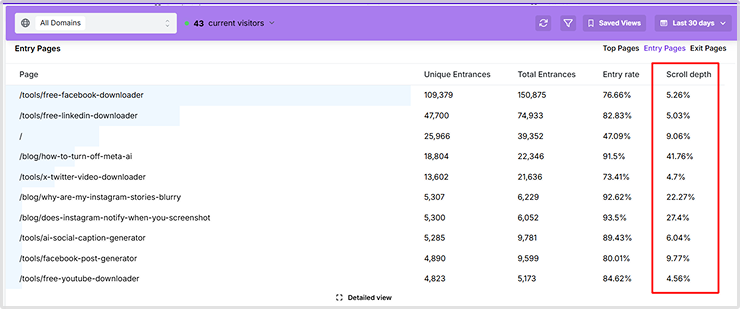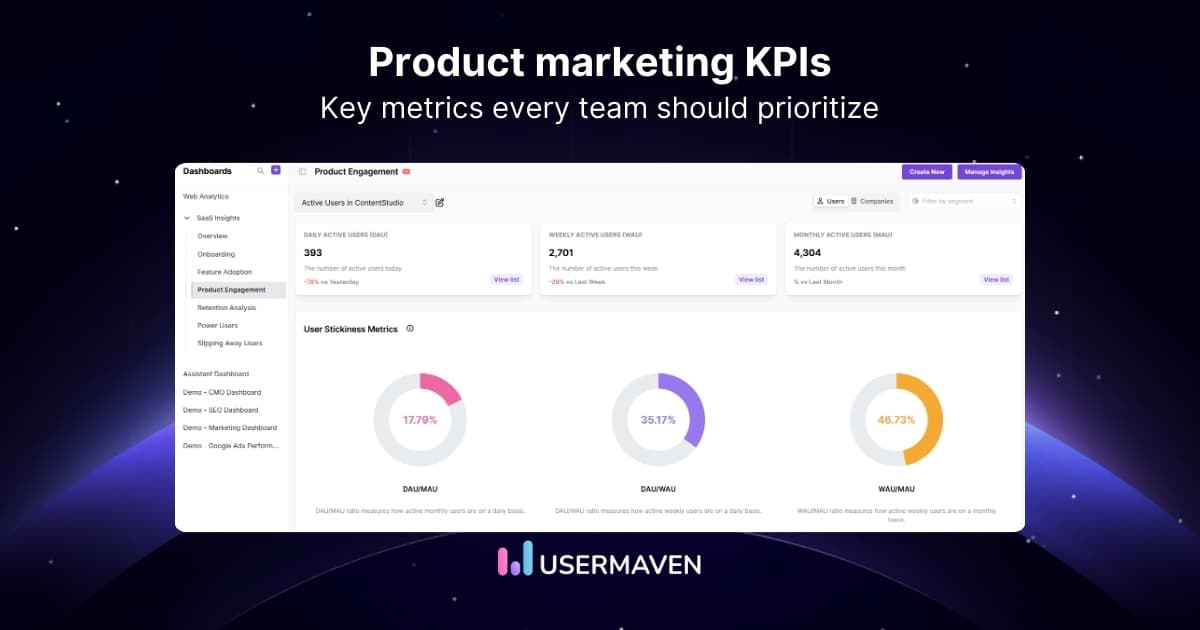The value of scroll depth and how to track it
Apr 14, 2025
6 mins read
Written by Usermaven

Understanding the specific sections of a web page can be a valuable asset for digital marketers, UX designers, product teams, and e-commerce managers. It identifies the sections that capture the attention of your website visitors or make them leave your website.
By monitoring scroll depth, you can harness this capability, offering actionable insights to enhance the user experience by uncovering your site visitors’ scrolling patterns. In this article, we discuss the scroll depth in detail, its significance, and various methods to measure it.
What is scroll depth?
Scroll depth is an engagement metric that measures how far down a webpage a user scrolls when viewing it.
It indicates the portion of a webpage that a user has engaged with by scrolling and is usually represented as a percentage. It is often combined with other metrics like time on page, bounce rate, and click-through rate to obtain a complete picture of user behavior.
Website owners, digital marketers, and content creators use this metric to understand how users interact with their content and website design. It unlocks insights that help improve content visibility and customer experience.
What is a good scroll depth?
A “good” scroll depth can vary depending on your website’s goals and content. There isn’t a universal benchmark for what constitutes a good scroll depth because it depends on factors like the type of content, user intent, and the overall design of the webpage. A good scroll depth for one website or page may not be the same for another.
For instance, a scroll depth of 25% with a low bounce rate is good. It indicates that your users are clicking on the CTA and not leaving the website. But the same would not be a good scroll depth for a long-form webpage. This indicates that the users are not reading the content in depth. Usually, a scroll depth of 75% is a good indicator of user engagement with long-form content.
Key considerations related to scroll depth
It’s important to note that many scroll tracking methods are inaccurate because they rely on a limited number of on-page scroll triggers, such as those at 25%, 50%, 75%, and 100% scroll points.
It means that if a user scrolls to 38% of the page, it will be recorded as a scroll depth of 25% since they didn’t reach the next trigger of 50% scroll depth.
When determining an appropriate scroll depth for your page, it’s essential to consider this imprecision. If a critical page element appears at the 40% mark, adjust your scroll triggers accordingly to capture user interactions accurately.
You can keep a note of the following key considerations while determining what constitutes a good scroll depth for your website:
- Assess scroll depth in the context of your content: Long-form articles or in-depth guides may naturally have higher scroll depths, while a landing page with a specific call to action may not require users to scroll much.
- Consider your website’s goals: A higher scroll depth may be desirable if you aim to provide valuable information on a page. If you aim to get users to take a specific action, the scroll depth might be less important than the conversion rate.
What is the significance of scroll depth?

The significance of scroll depth lies in its ability to provide valuable insights into user behavior and engagement on a website. Let’s look at some key reasons why scroll depth is significant.
1. Data-driven decision-making
Over time, monitoring scroll depth can help you identify trends and patterns in user behavior. For example, you might notice changes in scroll depth based on seasonality, marketing campaigns, or content updates.
Scroll depth data lets you make data-driven decisions about your website’s design, content strategy, and user experience. It can help you prioritize improvements and allocate resources effectively.
2. User engagement and experience
As mentioned, scroll depth directly indicates how deeply users are engaging with your content. It tells you whether users are scrolling past the initial content, indicating a higher level of engagement, or if they are bouncing off the page without engaging much.
A deep scroll depth often suggests that users find your content valuable and informative. It can contribute to a positive user experience and increase trust in your website and brand.
Given the prevalence of mobile devices, scroll depth is also significant in assessing the mobile responsiveness of your website. It helps you understand how users interact with your site on smaller screens.
Also read: Engagement Rate: Importance and Key Metrics
3. Content performance and optimization
Scroll depth helps you evaluate the performance of different sections of your webpage or individual pieces of content. You can identify which parts of your content capture user attention and which need improvement.
By analyzing scroll depth data, you can pinpoint areas of your webpage where users tend to drop off or lose interest. It can guide you in optimizing those sections to keep users engaged on your site longer.
Scroll depth also contributes to crafting a polished content strategy. If users scroll past a certain point consistently, it may indicate a need for more content in that area or a different content structure to serve user needs better.
4. Conversion tracking
For websites with specific conversion goals, such as e-commerce sites or lead generation pages, scroll depth can be a valuable component of conversion tracking. It lets you understand how far users scroll before taking a desired action, which can inform conversion rate optimization efforts.
When conducting A/B tests to optimize various elements of your webpage, including layout, content, or calls to action, scroll depth can be a valuable metric to determine which version performs better regarding user engagement and retention.
How to track scroll depth?
You can use multiple ways to track scroll depth. These methods offer different levels of technical complexity and flexibility. The choice depends on your technical skills and specific tracking needs. The most common methods are described below:
1. Third-party website analytics tools
Various third-party analytics tools, like Usermaven, Hotjar, and Crazy Egg, offer built-in scroll depth tracking as part of their feature sets.
Third-party tools offer user-friendly dashboards that simplify scroll tracking setup and data analysis. These tools typically provide session recordings, offering visually intuitive insights into user behavior.
Implementing scroll tracking with these tools often involves adding their tracking code to your website, which is relatively straightforward. In addition to scroll tracking, these tools often offer a wide range of other analytics and usability features.
Many third-party analytics tools come with a cost, which can vary based on the level of features and usage. Using third-party tools may raise data privacy concerns, as external providers often process user data. While these tools offer ease of use, they may limit your ability to customize tracking according to specific requirements.
Depending on your website platform and requirements, integrating third-party tools can sometimes be complex. Let’s look at how Usermaven deals with these concerns and provides a great scroll-depth solution.
Usermaven
Usermaven is a website and product analytics tool that allows businesses to make informed decisions based on their data. Its powerful features help your business grow with comprehensive and privacy-friendly data analytics. It is hosted in the EU and is compliant with privacy regulations like GDPR and CCPA.
You can measure the scroll depth of your landing pages and web pages along with other metrics. Unlike other analytics tools, Usermaven allows you to track scroll depth beyond the predefined scroll depth thresholds of 25%, 50%, 75%, and 100%. Thus, you can gain a granular understanding of specific intervals where users tend to stop, pause, or engage more deeply.
Moreover, websites with long-form content or intricate user journeys may benefit from custom scroll tracking to match the complexity of their content.

Beyond the standard thresholds, tracking custom scroll depths can reveal additional drop-off points where users may exit your page. This information is valuable for identifying content that may be causing users to leave prematurely, allowing you to make adjustments to retain user interest.
By analyzing user behavior at various scroll depths along with other website metrics, you can optimize content placement, calls to action, and overall content structure to better align with user preferences.
2. JavaScript
JavaScript programming language can be used to measure scroll depth by adding custom scripts to your web pages.
It offers full control over scroll tracking implementation, allowing you to tailor it to your requirements. You can set custom scroll depth thresholds and trigger events or actions based on user scroll behavior.
Implementing scroll tracking using JavaScript doesn’t rely on third-party tools or services, giving you full autonomy over your tracking. You can access scroll depth data in real time, which can be valuable for immediate analysis and feedback.
However, implementing scroll tracking with JavaScript requires coding skills, making it less accessible for non-developers. Custom JavaScript implementation can be time-consuming, especially for complex tracking scenarios. Also, you are responsible for maintaining and updating the tracking code, which can become cumbersome as your website evolves.
3. Google Analytics and Google Tag Manager
Google Analytics (GA) and Google Tag Manager (GTM) provide a more user-friendly way to track scroll depth without extensive coding.
Seamless integration with Google Analytics allows for easy consolidation of scroll depth data with other website analytics. GTM offers predefined triggers for common scroll depth thresholds (e.g., 25%, 50%, 75%, 100%), simplifying implementation. Once set up, GTM and GA tracking require minimal maintenance, and updates are managed within the platforms.
While GTM and GA provide easy implementation, they may lack the level of customization and flexibility that advanced users or complex tracking scenarios require. Data collected through GTM and GA may not be in real-time, and a delay can occur before it’s available for analysis. Since you rely on Google’s tracking services, it may not align with your data privacy or compliance requirements.
Website analytics tool for modern marketers & agencies
*No credit card required
Conclusion
Scroll depth is significant because it provides actionable data that can inform website optimization, content strategy, and user experience enhancements. By understanding how users interact with your content and where they engage or disengage, you can make informed decisions to improve your website’s performance and achieve your goals. Data analytics tools like Usermaven come to your aid in tracking not just scroll depth but other website metrics.
Key features of Usermaven include cookie-less tracking using white-label pixel technology, which offers highly accurate statistics while bypassing ad blockers. It ensures 100% data ownership, with analytics securely stored on their cloud server, giving users control over their data without data mining or monetization.
Other prominent features include marketing attribution, funnel analysis, engagement metrics, feature adoption reports, retention cohort analysis, and customer segmentation. In short, Usermaven is a versatile solution for marketers and product teams looking to grow their businesses. Sign up today for Usermaven.
FAQs
1. What is the average scroll depth?
The average scroll depth on a website varies depending on factors like content type and user behavior. Generally, a scroll depth of 75% is considered good for a webpage with long-form content. A depth of 50% or less might be good for conversion-focused websites.
2. Why is natural scrolling better?
Many users and experts argue that natural scrolling is better for several reasons. Natural scrolling aligns the digital experience more closely with real-world physical actions. It reduces cognitive load because users don’t need to think about a separate set of rules for scrolling on digital devices compared to physical actions.
3. What are the different types of scrolling?
There are several different types of scrolling methods, each designed to provide a unique user experience. Long, infinite, and parallax scrolling are some scrolling types.
4. What is the difference between parallax and infinite scrolling?
Parallax scrolling creates an illusion of depth by moving different layers of content at different speeds as the user scrolls, while infinite scrolling continuously loads new content as the user reaches the bottom of a page or list, commonly used in social media feeds.
5. Why is 90% scroll depth considered as reaching the bottom of a page?
Larger websites usually have the footer as an extra navigation menu, offering convenient quick links for users to explore further. It is especially beneficial on smartphones, where reaching the top to access navigation menus can be cumbersome.
Try for free
Grow your business faster with:
- AI-powered analytics & attribution
- No-code event tracking
- Privacy-friendly setup


